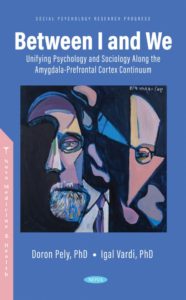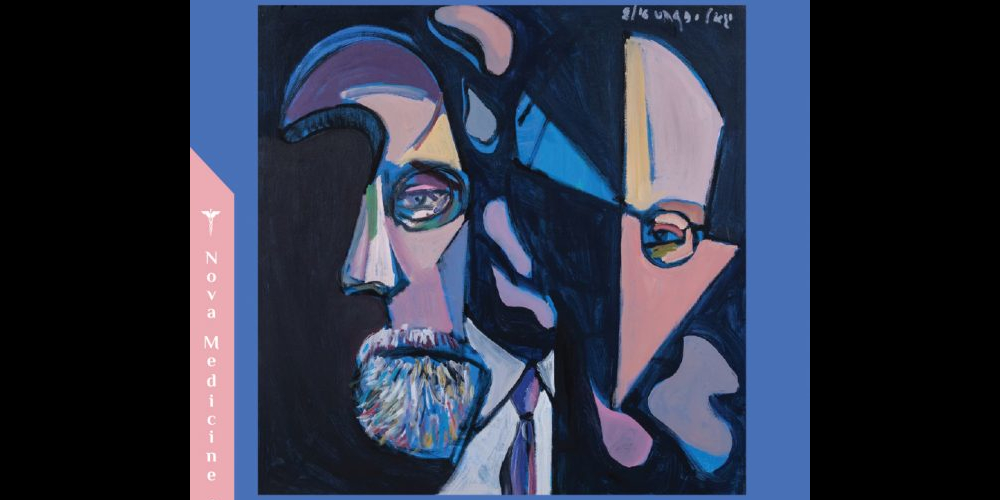By Dr. Doron Pely and Dr. Igal Vardi
How and Why Exploring Psychology, Sociology and Neurology Together, as Functionally Related Disciplines, Can Help Understand and Predict the Actions of Individuals and Communities Alike
Human beings are profoundly social animals. From birth to death, humans don’t really exist in isolation from each other; they exist in communities of various sizes, from families to nations, where they learn and teach each other endlessly, create concepts, ideas and generate complex behaviors that, in turn, give rise to more concepts and ideas – a never-ending cycle that binds humanity at the same time that it separates it into identity-based groups of all sizes and descriptions.
 Scholars and practitioners tend to focus on either individuals (psychology) or communities (sociology), but despite the obvious bond between the two disciplines – both examine the behavior of human beings in various contexts – the two disciplines often have a difficult time finding common terms of reference, and a functional language that will lead the way towards greater shared insights and better predictive capabilities regarding how individuals and groups perceive, feel and behave. In our new book, Between I and We: Unifying Psychology and Sociology Along the Amygdala-Prefrontal Cortex Continuum, we attempt to provide a constructive approach to bringing the two disciplines closer, using neurology as a bridge.
Scholars and practitioners tend to focus on either individuals (psychology) or communities (sociology), but despite the obvious bond between the two disciplines – both examine the behavior of human beings in various contexts – the two disciplines often have a difficult time finding common terms of reference, and a functional language that will lead the way towards greater shared insights and better predictive capabilities regarding how individuals and groups perceive, feel and behave. In our new book, Between I and We: Unifying Psychology and Sociology Along the Amygdala-Prefrontal Cortex Continuum, we attempt to provide a constructive approach to bringing the two disciplines closer, using neurology as a bridge.
In the past, there have been many attempts to bridge the individual-group gap. Charles Darwin was as preoccupied with the collective expression of biological existence as he was with the individual. Likewise, Sigmund Freud started by delving into the mysteries of the individual’s mind but moved on to a collective-centric exploration, with his book, Group Psychology and the Analysis of the Ego.
We know that individuals and groups exhibit a wide spectrum of similar traits at the psychological, sociological, neurological, emotional, behavioral, and cognitive levels. They get scared, develop and exhibit fear, get angry, adopt and/or enact biases, feel empathy, hate and disgust, lash out, retreat and become immobile; they develop an identity and a character and use them (as well as being used by them) to paint the rich, ever-evolving, tapestry that is the human story. Understanding the behavior of individuals and groups alike is difficult without understanding how the elements and the whole interact, what happens to them when they do, and how the interaction begats a wide spectrum of behaviors.
Yet, despite attempts to bridge psychology and sociology (e.g., social psychology, psycho-sociology) the sciences of the individual and the collective continue to stand far apart. Knowledge falls between the gaps. Psychologists tend to ignore groups, particularly the fascinating phenomenon whereby, once collectives which are supposedly just aggregates of individuals are created, they are no longer reducible to their constituent parts. Sociologists, for their part, pay little attention to individual traits; both disciplines speak different ‘languages’, and, even more importantly, both tend to largely ignore the neurological foundations of all behaviors – the brain and its input and output systems, both reactive (fast and furious, controlled significantly by the Amygdala), and responsive (slow and contemplative, controlled substantially by the Pre-Frontal Cortex). After all, neurology speaks, still another language, that is largely ‘foreign’ to scholars and practitioners of other disciplines. The result: essential theories, such as social identity theory, go unshared, as do recent useful, experimentally derived, neurological insights that may help develop important predictive capabilities, whose utility cuts across disciplines.
Efforts to bridge the gap between the disciplines continue. The German-American psychologist Kurt Lewin argued that it is impossible to understand psychology without its association with sociology. To examine this proposition, Lewin developed the discipline of social psychology. The Russian psychologist, Lev Vygotsky wanted to know whether the need to communicate socially accelerated the neurological development of the brain in the expansion of the functionality of language or whether the brain’s evolutionary changes enabled such expanded communication. Another path, which we support is that of closed feedback circularity, where neurology and social communication are interwoven, supporting and promoting each other.
With the introduction of new investigative technologies and techniques, researchers and scholars are coming to the realization that it is impossible to define and explain individuality, in biological, psychological and even neurological terms without taking into account the most unique expression of the individual unit – the group (e.g., family, clan, tribe, nation). For example, where there was exploration of the individual consciousness, there is now a flourishing scientific examination of collective consciousness. Investigation of the neurological intricacies of the individual is expanding into the relatively new discipline of neurosociology.
We think that it is time to give a rapprochement between psychology and sociology another honest try – this time around with the help of the bridging services of neurology. Hence, our new book: Between I and We – Unifying Psychology and Sociology Along the Amygdala-Prefrontal Cortex Continuum, enlists centuries of human exploration and experience, to provide the first disciplined attempt to bring together humanity’s two ancient-yet-ever-renewing efforts at self-understanding. We do this by mapping a common cognitive and behavioral path that merges what we know about the conscious and unconscious, the rational and irrational, the pragmatic and the incorporeal – at both the individual and the group levels – along the unifying continuum of the Amygdala-Prefrontal Cortex spectrum. This is a continuum that describes the relative, proportional, inter-relations between the instinctive-reactive (amygdala) and the contemplative-responsive (prefrontal cortex), the fast and the slow, the coarse and the nuanced.
The book presents the reader with a new paradigm that tries to answer the question: Is it possible to understand the behavior of individuals and collectives along a common set of concepts and mechanisms, both anatomical and metaphorical? Can we understand the fascist, conformist, liberal and anarchist – at both the individual and collective levels – through an examination of the relative dominance of the amygdala and/or prefrontal cortex, and their derivative exhibition of resultant behaviors? Can we construct a coherent explanation of the behavioral continuum that stretches – in both individuals and collectives – between the extreme behavior of amygdala hijack reactivity of the full-amygdala control and oppositely extreme analysis-paralysis pole describing a pre-frontal cortex gone rouge?
The book makes use of two newly coined functional metaphors: social amygdala and social prefrontal cortex. These two metaphors help create a helpful symmetry between the individual and collective domains, a neurological bridge of sorts that hopefully sheds useful light on the link between the individual and the group, and on the insights that may be drawn from this link. It argues that the individual-group similarity may be deeper than we think. That is because it turns out that the reaction-response ‘mechanisms’ that drive much of our practical and emotional experience, exist not only at the level of the individual, significantly along the amygdala-prefrontal cortex continuum, but also at the level of the group. In other words, where we can identify reactive, amygdala-driven, features in the individual – particularly, freeze, flight and fight reactions – we can also identify similar ‘social amygdala’ reactions at the group level. Conversely, where we can identify responsive, prefrontal cortex-related attributes in the individual – complex cognitive behavior, planning and executing, decision making, conflict moderation, executive functions – we can identify similar ‘social prefrontal cortex’ attributes and features in every type/size of group.
Functional metaphors are extremely useful instruments of conceptualization. Take, for example Freud’s id, ego and super ego – these are popularly accepted and hugely useful metaphors. They do not map directly to corresponding anatomical regions, but they certainly point to functionally significant regions of our mind, and enrich our ability to map, describe, explain and make predictions based on these metaphorizations. We believe this model helps not only to fuse psychology and sociology along a neurological continuum, but also helps explain a wide spectrum of individual and collective behaviors.
The book uses Martin Buber’s “I and You” duality as its exit point and broadens the exploration to cover a more inclusive “I and We” – the individual and the collective – in their psychological, sociological and neurological entirety. It addresses many questions, including: Why would we want to unify our exploration of psychology and sociology and how could we do it? Where and when does the individual end and the collective begins? Where do neurology and sociology meet? How did we evolve from fight, flight, and freeze reactivity to strategic analysis responsiveness? What is the link between politics and the amygdala? What is the place of biases, emotions, attention, and empathy in the life of the individual and the group? What is the reaction-response continuum, and how does it play a role in the life of individuals and collectives? Can we describe and explain social organizations such as fascists, liberals and anarchists along the amygdala-prefrontal cortex spectrum continuum?
Based on current knowledge, it is difficult to envision a serious scholastic endeavor in either psychology, sociology or neurology that does not require taking into consideration neighboring disciplines at some point.
Why is this relevant to the Safe Communities Institute and its mission? Because public safety and security is hugely predicated on the behavior of individuals and communities alike. Absent clear understanding of what drives such complex behaviors, we stand little chance of being able to interpret them correctly and maybe be able to mitigate against some of the more destructive outcomes of such behaviors. This book is an attempt to expand the discussion and exploration of the vast area of knowledge that bonds psychology, sociology and neurology.


